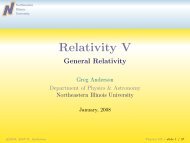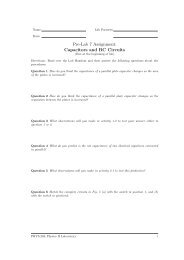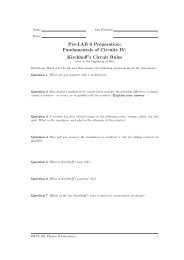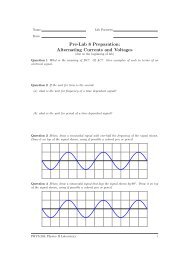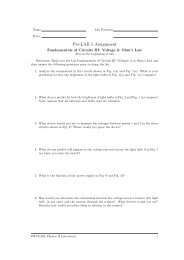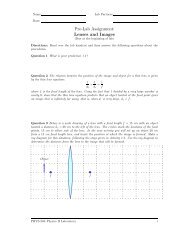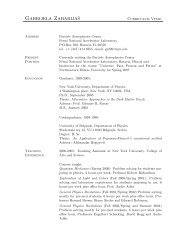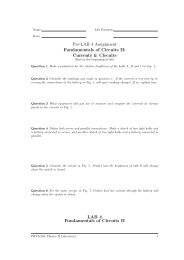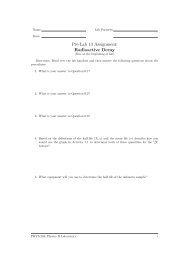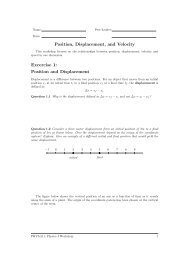Fundamentals of Circuits I: Current Models, Batteries & Bulbs
Fundamentals of Circuits I: Current Models, Batteries & Bulbs
Fundamentals of Circuits I: Current Models, Batteries & Bulbs
You also want an ePaper? Increase the reach of your titles
YUMPU automatically turns print PDFs into web optimized ePapers that Google loves.
<strong>Fundamentals</strong> <strong>of</strong> <strong>Circuits</strong> I: <strong>Current</strong> <strong>Models</strong>, <strong>Batteries</strong> & <strong>Bulbs</strong> v 0.1<br />
Lets examine some common materials to see which are conductors and which are nonconductors.<br />
We can do that by determining which materials allow the bulb to light. You<br />
will need<br />
• common objects: paper clips, pencils, coins, rubber bands, fingers, paper, keys etc.<br />
Connect a single wire, the battery, and a bulb so that the bulb lights. Choose one <strong>of</strong> the<br />
arrangements drawn in your answer to Question 1.5. Then, with the help <strong>of</strong> your partner,<br />
stick in a variety <strong>of</strong> the common objects available between the battery and the bulb.<br />
Question 1.8 List the materials that allow the bulb to light.<br />
Question 1.9 List the materials that prevent the bulb from lighting.<br />
Question 1.10 What types <strong>of</strong> materials seem to be conductors What types seem to be<br />
non-conductors<br />
By now you will have discovered that it is difficult to hold your circuits together From<br />
here on, you can make it easier by using a battery holder and a bulb socket. These things, with<br />
the addition <strong>of</strong> a switch are found on the circuit board provided.<br />
Activity 1.4: Using a Battery Holder, Bulb Socket and Switch<br />
For this activity, in addition to the materials you’ve already used, you will need:<br />
• battery holder (for a D cell)<br />
• several wires (6 inches or more in length)<br />
• flashlight bulb socket<br />
• contact switch<br />
Step 1: Examine the bulb socket carefully. Examine what happens when you unscrew the<br />
bulb. Note which parts <strong>of</strong> the bulb make contact with which parts <strong>of</strong> the socket.<br />
Step 2: Examine the bulb closely.<br />
PHYS-204: Physics II Laboratory 6




